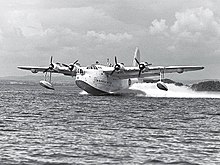 Short Sunderland Mk. III (similar aircraft) | |
| Accident | |
|---|---|
| Date | 25 August 1942 |
| Summary | Controlled flight into terrain |
| Site | Eagle's Rock, near Dunbeath, Caithness, Scotland 58°14.1781′N 3°30.5338′W / 58.2363017°N 3.5088967°W |
| Aircraft type | Short Sunderland Mk. III |
| Operator | No. 18 Group, Royal Air Force |
| Registration | W4026 |
| Flight origin | RAF Invergordon, Scotland |
| Destination | RAF Reykjavik, Iceland |
| Passengers | 4 |
| Crew | 11 |
| Fatalities | 14 |
| Injuries | 1 |
| Survivors | 1 |
Location of crash site
The Dunbeath air crash involved the loss of a Short S.25 Sunderland Mk. III that crashed in the Scottish Highlands on a headland known as Eagle's Rock (Scottish Gaelic: Creag na h-Iolaire) near Dunbeath, Caithness, on 25 August 1942.[1][2] The crash killed 14 of 15 passengers and crew, including Prince George, Duke of Kent, who was on duty as an Air Commodore in the Royal Air Force on a mission to Reykjavík;[3] a message of condolence was proposed in Parliament by Prime Minister Winston Churchill.[4] A Royal Air Force Board of Inquiry determined that the crash was the result of a navigational error by the crew.[5]
- ^ "Secret of duke's plane death". BBC News. 23 December 2003. Retrieved 22 June 2017.
- ^ Ranter, Harro. "ASN Aircraft accident Short Sunderland III W4026 Dunbeath, Scotland". Aviation Safety Network. Retrieved 22 June 2017.
- ^ "Mystery still surrounds Eagle's Rock air crash". John O'Groat Journal. Archived from the original on 4 February 2015. Retrieved 22 June 2017.
- ^ "Death of Air Commodore His Royal Highness the Duke Kent". Parliamentary Debates (Hansard). House of Commons. 8 September 1942. col. 42. Retrieved 23 June 2017.
- ^ "Aircraft Accident, Court of Inquiry (Findings)". Parliamentary Debates (Hansard). Written-Answers. 7 October 1942. col. 1228w. Retrieved 23 June 2017.

